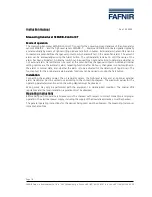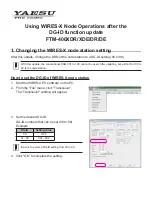
T14.0.1X.6C-04
Operating Manual GLMU 400 MP
page 4 of 8
7 Operation
7.1 General information about the conductivity measuring
7.1.1 The measuring cell
During the measurement, the conductivity measuring cell must be dipped at least in so far, that at least
30 mm beginning from the top of the measuring cell, is located in the medium.
The maximum immersion depth for continuous operation should not exceed 110 mm.
The measuring cell can either be stored dry or in water. After dry storage wetting time will be prolonged
slightly. If changing over from one liquid to another with conductivity varying widely make sure to properly
rinse the measuring cell with deionised water.
Attention: Measuring cell must never come into contact with water-repellent materials such as oil
or silicone.
If conductivity measured is much higher or lower than expected this may be due to the measuring being
soiled with non-conducting or conducting extraneous materials. The measuring cell has to be cleaned e.g.
with a watery soap solution.
When measuring media at low conductivity the measuring cell has to be stirred sufficiently.
7.1.2 Measuring hints
Conductivity measuring is comparably easy to perform, the precision of the instrument is very constant if it is
used as intended. Depending on the necessary accuracy the instruments can be used up to several years
without re-calibration of the cell constant.
If the accuracy should be controlled or improved, this is done by means of suitable reference solutions and
the adjusting of the cell factor.
Attention! Wrong handling of reference solution can make them useless very fast.
Measuring procedure:
Especially when measuring low conductivity: Before immersion to the measuring solution, rinse the measur-
ing cell with deionised water.
The measuring is speeded up considerably, if the measuring cell is immersed and pulled out the solution
several times. Especially when measuring low conductivity the measuring cell needs sufficient flow during the
measuring, e.g. via stirring the solution.
Sufficient time has to be waited for, until the measuring cell has adjusted to the measuring solution tem-
perature.
7.1.3 Temperature compensation
The conductivity of aqueous solution is temperature dependent. The dependency itself is strongly dependent
on the kind of solution. For the most applications e.g. in fish farming etc., the non linear temperature com-
pensation of natural waters is precise (“nLF” according to EN 27888). The most common reference tem-
perature is 25 °C.
7.1.4 .Salinity measuring
The salinity (salt content) of seawater can be determined in the measuring mode „SAL“ (basis: International
Oceanographic Tables; IOT)
The salinity of standard-seawater is 35 ‰ ( 35 g salt per 1 kg seawater).
The values are displayed in ‰ (g/kg).
7.1.5 TDS measuring
At the TDS measuring the dry residues or
t
otal
d
issolved
s
olids value is calculated by means of the conduc-
tivity and a calculation factor (C.tdS). This factor has to be evaluated for the referring type of solution.
The values are displayed in mg/l.


























